Warm up this winter with Oma's newest cookbooks - available on Amazon >>
- Home
- Famous Churches in Germany
Famous Churches in Germany : Cathedrals and Churches worth visiting
By: Lydia Fulson / Writer, Pyrography Artist, Thrill Seeker, and Traveler
Let's look into some of the most memorable and famous churches in Germany. These churches and cathedrals are unlike any other and simply scream character and beauty!
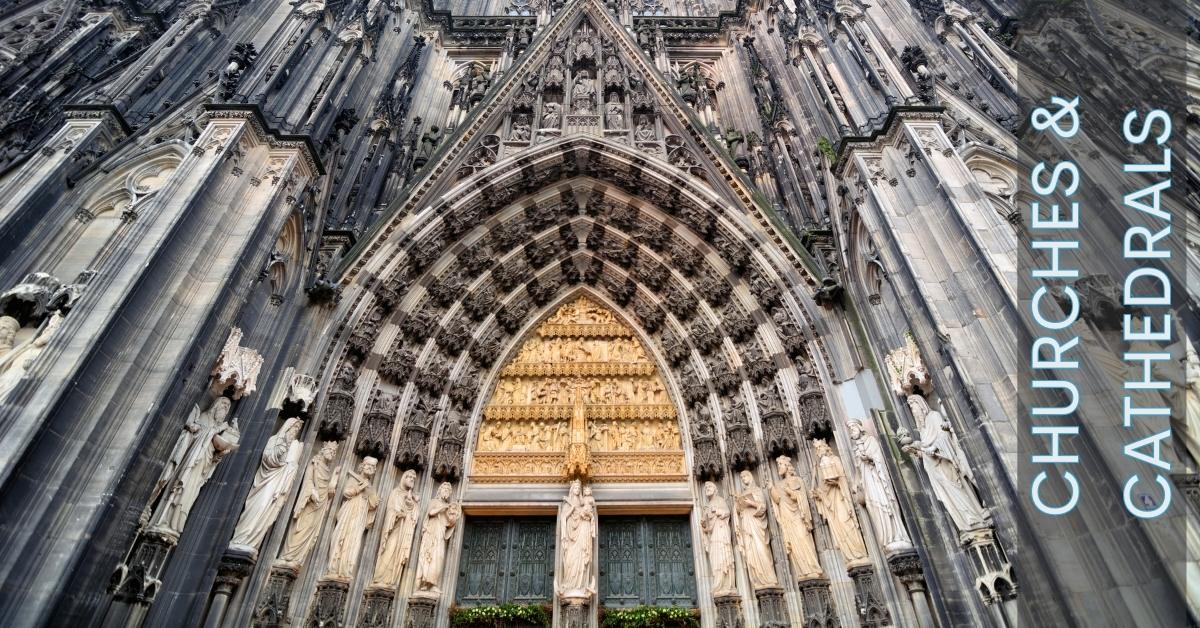
Germany's famous cathedrals and churches are beyond what words can describe. The work that went into making them the perfect spots for worship and tourists alike is amazing. But what makes a church different from a cathedral?
On this page:
What's the Difference Between Churches and Cathedrals?
Architecture
The biggest difference between churches and cathedrals that is the most noticeable from the outside is the architectural styles.
Churches tend to be much more classic and simple in style, depending on the denomination. On the other hand, cathedrals are much more large-scale and intricately detailed, like the massive Cologne Cathedral. Many cathedrals follow the Gothic architectural styles, using characteristics like pointed arches, gargoyles, and traceries, referring to the stone frames that hold in the beautiful stained-glass windows and statue columns.
Statue Columns
Statue columns are when the buildings have small or large columns with statues or figures inside them.
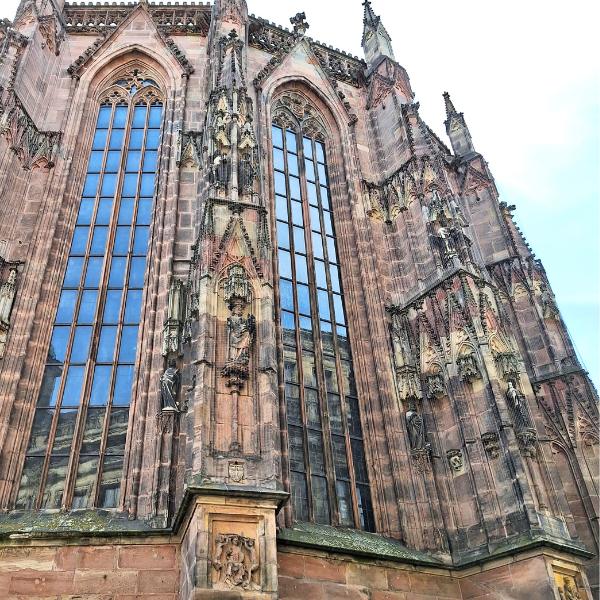
In the photo above, I took this in Nürnberg (Nuremburg) when I spotted the statue columns. They're one of my favorite parts of Gothic cathedral architecture and gargoyles. They just don't make buildings this detailed anymore. Not here in Canada, at least! But not everybody thought it was so great.
When Gothic architecture was first introduced, it was questioned by many. The thought of having erratic and chaotic decor on such holy buildings left people skeptical, thinking, "Why not just keep them flat and basic looking...?"
But it was quickly embraced as they opened up to the idea that intricacy and artistry incorporated into religious settings isn't always bad, and that having the cathedrals built at larger scales would attract more people to come and join.
Gargoyles
Gargoyles have been a huge part of Gothic culture and architecture for hundreds of years. But they serve more than a decorative purpose when added to cathedrals. You'll notice them, especially on the taller cathedrals. This is because gargoyles double as decoration and as rainfall management.
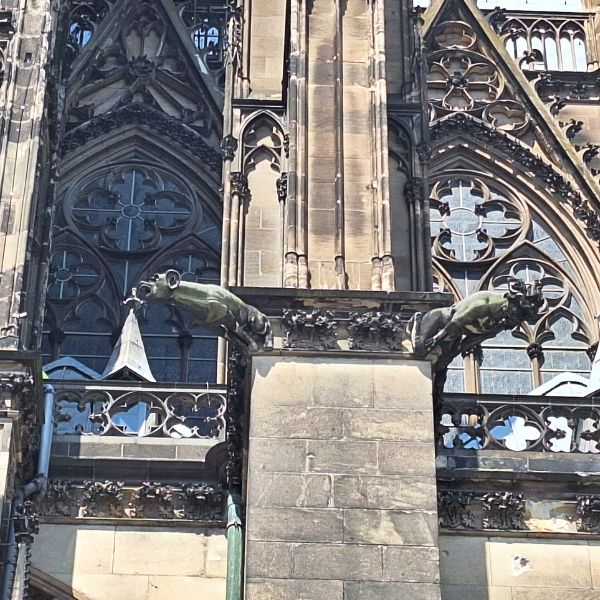
The gargoyles help flush the water collecting on the many roof peaks. They are often equipped with tubes coming out of the mouths, and this is where the water collects and drains.
They also were used as a symbol of safety. Gargoyles are added to the building to show people that it is a safe space away from any evil, specifically evil spirits.
Leadership
Bishops are often the leadership in cathedrals. An easy way to remember this is by the name itself.
The name 'Cathedral' comes from the Latin word cathedra, meaning chair. This is referencing the bishop's seat in the cathedral.
Remarkable Famous Churches
St. Thomas Church in Leipzig
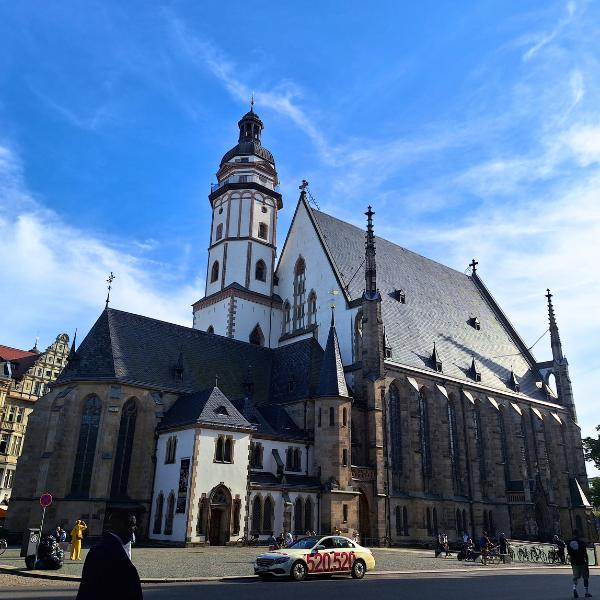
St. Thomas Church, located near Leipzig's market square, is the final resting place for one of the world's most famous composers, Johann Sebastian Bach.
Not only is it the resting place of an unforgettable musician, but Martin Luther also preached here. The late Gothic-style church standing today used to be where an old 12th century Romanesque-style church was located. Its foundation in the shape of a cross was uncovered, and the new St. Thomas Church used this foundation to start a fresh new building.
Since then, many visitors, tourists, and famous folk have stepped through its doors. St. Thomas has had a few revamps and rebuilds due to World War II, leaving the finishing building seen by thousands every day.
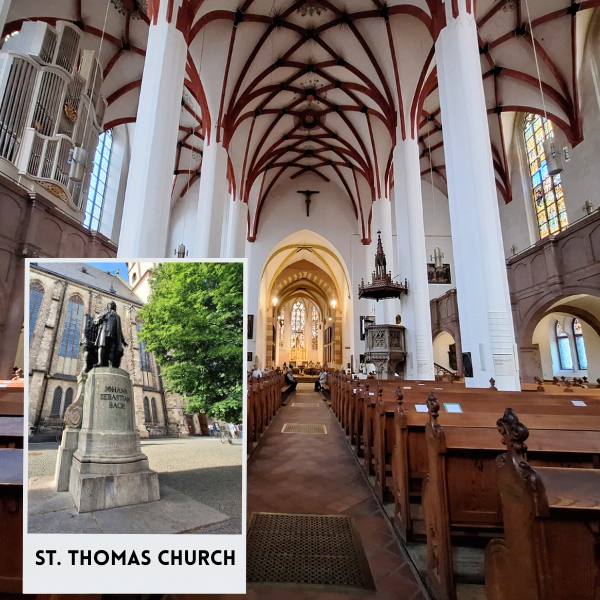
More commonly known just as Bach, the prodigy's music and memory live on throughout the town and church in Leipzig.
Bach was the leader and music director of St. Thomas for nearly thirty years. His grave can be found inside. It's not overly extravagant, but tasteful and … hopefully, the right guy. Yes, there is a chance that the remains buried in St. Thomas aren't at all that of Bach.
Bach's body had been reburied and relocated a few times, but it was hard to signify which bones were his when relocating from the St. John's Church to St. Thomas. When he was buried, it wasn't uncommon for there to be unnamed mass graves. So, whether it's him or bits of him … it's the thought that counts.
Pilgrimage Church of Wies in Bavaria
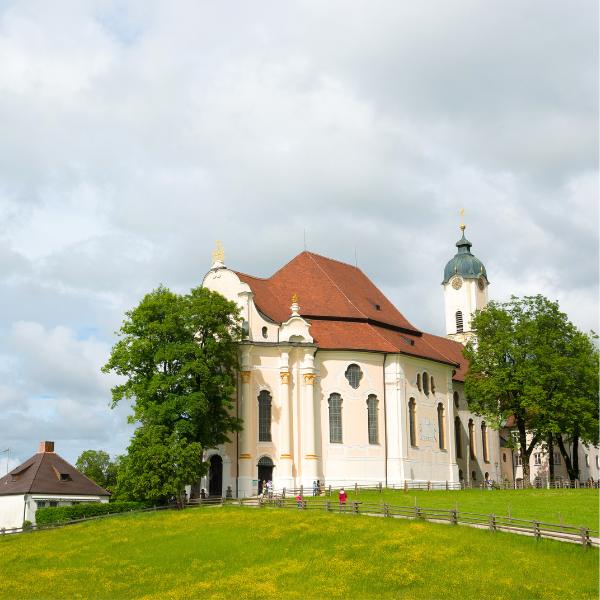
The Pilgrimage Church is located in Bavaria in the Weilheim-Schongau district. Some may say, in the middle of nowhere. The Pilgrimage Church of Wies' scenery is serene and rural, and its architecture speaks for itself.
Its name came from the church being a popular destination for traveling pilgrims. After the first handful came and prayed upon the altar, they returned to their friends and said that they had been healed from any illness they had. This led to flocks and massive groups coming to visit the little church.
Its murals weren't added until after the influx of visitors. Designers wanted to make it as beautiful and eye-catching as they could to keep the people coming.
Fancy pants
It's quite the difference walking from the outside to the inside. The outside Rococo characteristics are simple and classy, but the intricacies of the inside will leave you in awe.
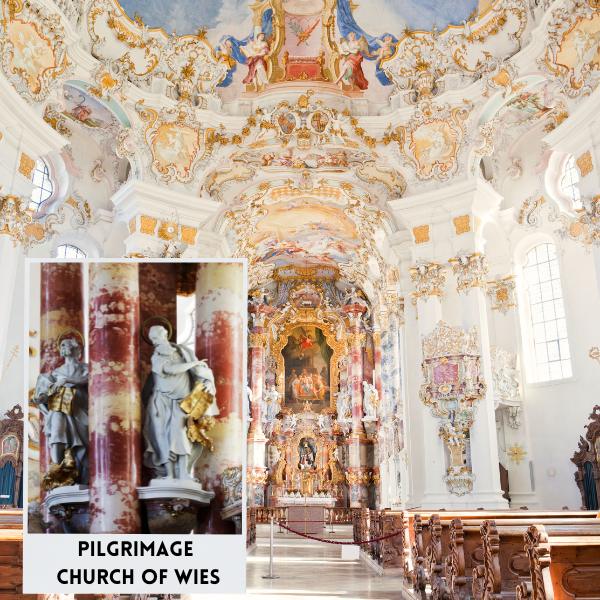
The church was designed and built in 1740 in Rococo style, with intricate and artistic details throughout. Rococo architecture is made to be all-around pleasing to the eye. All murals were hand-painted inside. Due to its amazing details, the work that went into it and its popularity, the Pilgrimage Church of Wies made it onto the UNESCO World Heritage Site list.
Take your time as you go through this beauty. Notice the bold details getting louder as they surround the altar. Don't let all those intricately placed statues and golden spirals go unnoticed!
It's no Gothic cathedral the size of a skyscraper, but it's impressive in its own ways, that's for sure.
St. Nicholas Church of Potsdam
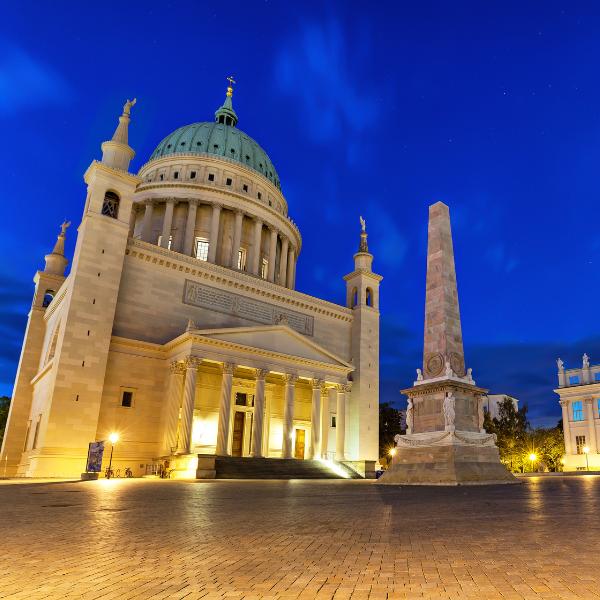
St. Nikolaikirche is a Lutheran church, a well-crafted 84-yard-high beauty. All I can think of when I see this building is “mini Taj Mahal”.
The church towers over the town of Potsdam with its bright dome and signature gold cross situated up top. It's hard to miss as it's located smack dab in the middle of the town's downtown market square or Alter Markt. Pretty near every city in Germany has its main market square, and Potsdam's gives a real Mamma Mia in Greece vibe.
Did you know that the architecture of St. Nicholas was drawn with the design of a Greek cross? These Greek crosses are designed with all arms of equal length. The church's round apse, the semicircular dome, is at the end of one arm of the cross.
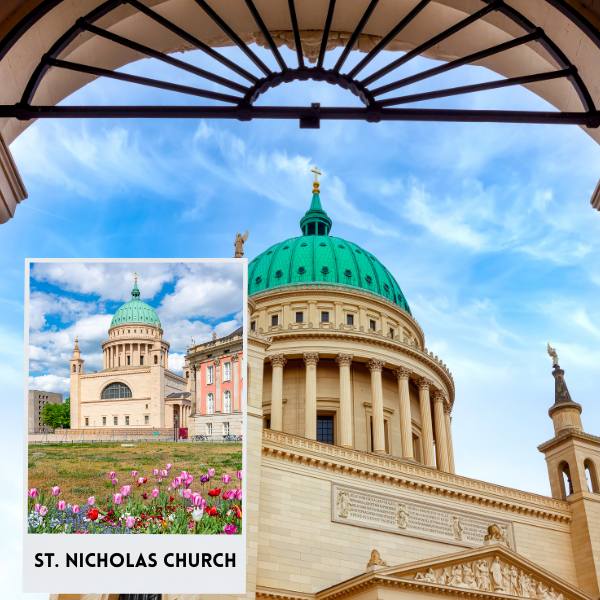
Take photos of the elegant church courtyard, always manicured and sculpted perfectly, and then sit to enjoy the astonishing sight in front of you on one of the courtyard benches.
Mamma Mia! That's dedication.
This poor church was consecrated three times due to fires and war damage. But the square-shaped cross plans drawn out by the brilliant Prussian architect Karl Friedrich Schinkel were redesigned until it was exactly how the artist envisioned.
As an artist myself, I concur. It takes a few tries to get things precisely as envisioned; things never really come out that way. You have to find a new vision along the way and run with it. So, I admire Schinkel's commitment.
ahh, Music to the ears
For a small 5 euro fee, you can explore the church and climb to the viewpoint of the tower for an extraordinary view of the town.
St. Nicholas Church is known for having upbeat musical services, welcoming hundreds of visitors every Sunday, and yes, of course, tourists are welcome to join.
Keep an eye on the church's schedule, as this beautiful building is also the host of organ concerts. There's nothing like that old organ sound!
St. Bartholomew Church of Bavaria
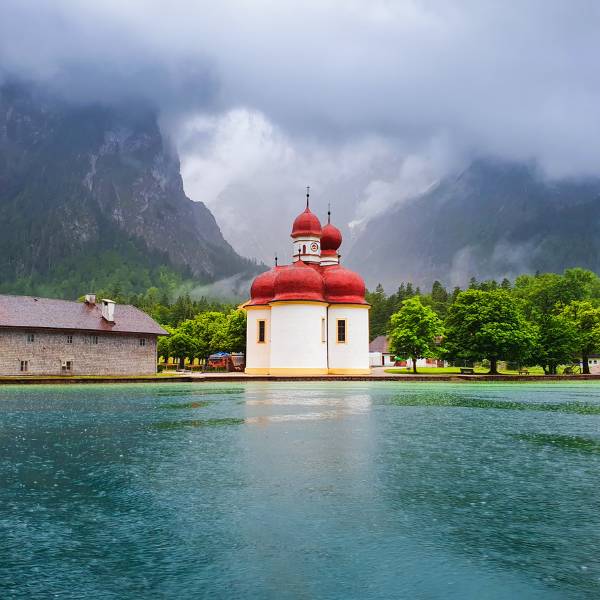
Picture-perfect Bartholomew is a Roman Catholic church built in 1697 in the Baroque bubbly style with classic 'onion' domes.
Like the Church of Wies, this one is also a Pilgrimage church. It is part of an annual pilgrimage held every Saturday after 24 August from Maria Alme in Austria to the Berchtesgaden Alps, and St. Bartholomew is a stop along the way.
It's a painting. it's a postcard. No, It's Bartholomew!
This church is unlike anything you've seen before. It's like a fairytale nestled in the mountains on the western shore of the Königssee lake in Bavaria.
There's a reason this is such a cool place to stop by. And that's because it's not exactly the most accessible place to just … stop by, unless you have your boating license handy or have extremely good endurance.
Bartholomew is only accessible by boat or if you hike for miles through the Alps to reach it. Hmm, a boat ride sounds pretty nice now, huh?
That's what's great about Bartholomew. It's so private and hard to reach that it's never jam-packed with tourists, so the perfect photo opportunities are there for you to get without catching any strangers' photobombs in the background!
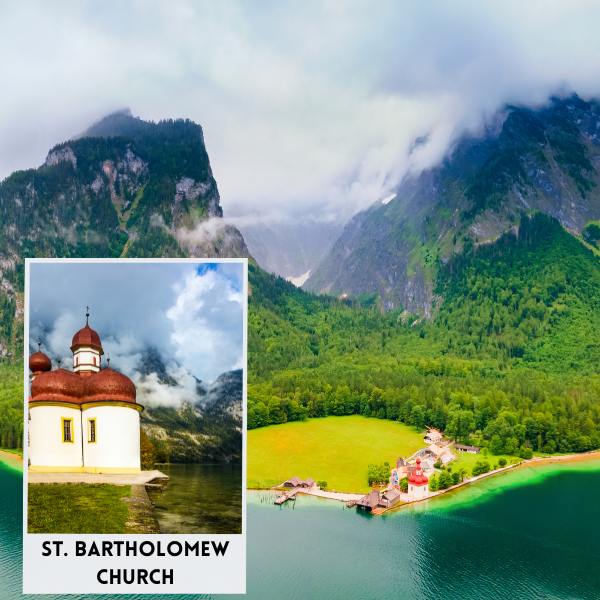
If the Price is Right
Private tours like Eagle's Nest Lake Königssee are a bit of a pricey option when it comes to getting to Bartholomew. If you're looking for luxury, this $635 US/ person cruise along the lake is for you.
If you're more like me and like to save money for things like authentic German rouladen meals instead, here's a MUCH cheaper option that might suit your fancy.
The Bayerische Seen-Schifffahrt boat tour company offers tours to Bartholomew for about $24.00 US roundtrip. Now that's more like it. On this tour, your captain will play an authentic flügelhorn to serenade you as you glide through the turquoise waters to your destination.
Famous Cathedrals Worth Visiting
Aachen Cathedral of Aachen
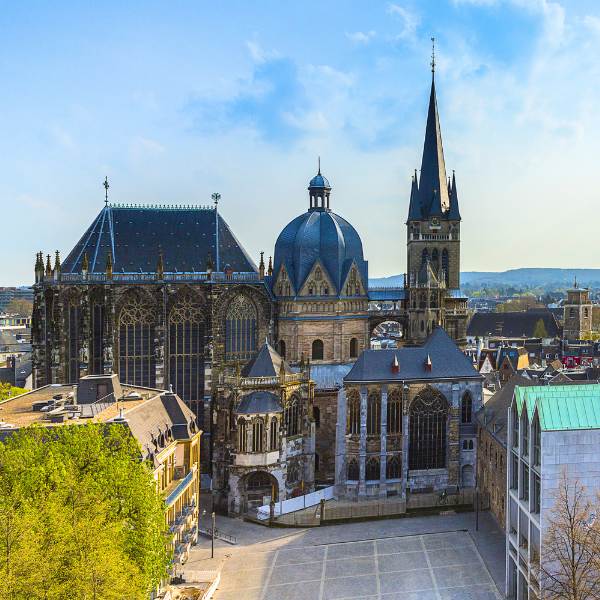
The Roman Catholic Aachen Cathedral, located in Aachen, North Rhine-Westphalia, is one of the oldest standing cathedrals in Europe. It's so old that it was one of the first places listed on the UNESCO World Heritage Site list.
The attention to detail is something to be recognized. The Aachen was designed in the Romanesque and Gothic architectural styles. As the centuries went on and styles kept changing, you can see the difference in styles.
An Oldie, But Always a Goodie
How old is the cathedral exactly? This mesmerizing cathedral was built all the way back in 803. Attached is the Palatine Chapel, which became a popular pilgrimage destination. It was built by Emperor Charlemagne, who spent ten years dedicated to building a masterpiece that would influence other churches around the world years thereafter.
This became the site of nearly 35 coronations of kings and queens.
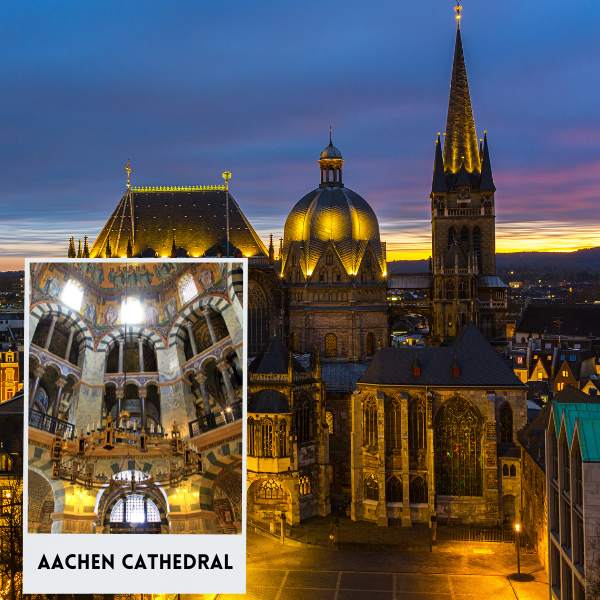
Attack of the Aachen
In the late 8th century, the freshly built Roman Catholic Church was heavily damaged due to Viking raids coming from Scandinavia. Being one of the most popular religious structures, it became an easy target.
Like many other famous churches and cathedrals in Germany, the Aachen was also damaged by an air raid in World War II. The Cathedral was taken right down to the bones. Its only standing structure left was its foundation. But with the help of a wee $43,000,000, we now have a new and improved Cathedral to see, with new Gothic elements to take in.
Cologne Cathedral in Köln
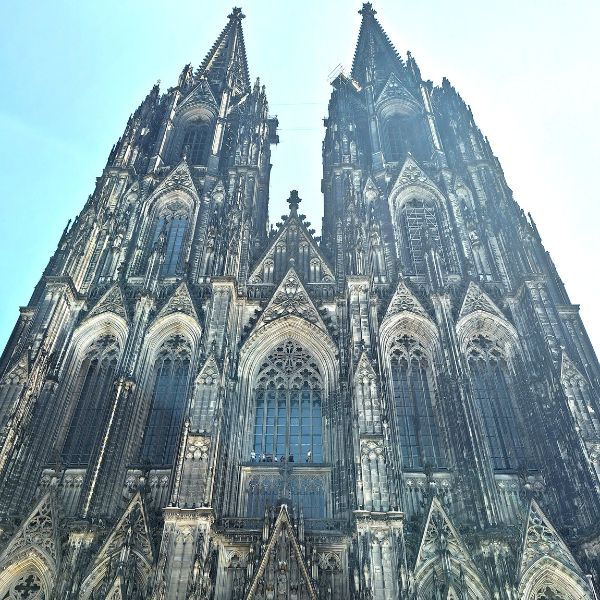
Seeing THE Cologne Cathedral in person is an unforgettable and jaw-dropping experience. It is large and in charge! It's the largest Gothic Cathedral in all of Northern Europe. This is the true display of Gothic architecture, checking off every box, from its many gargoyles to its statue columns and spires with intricate detailing.
One could easily spend hours here just staring in amazement at the sheer size of it. The dual spires of the towers make an impressive statement that can be seen from anywhere in the city that it became open to in 1880.
See the view from below and up top. Yes, there is a staircase in the south tower that leads you past the many enormous bells and to a viewing platform where you can tower over Cologne, just like the Cathedral!
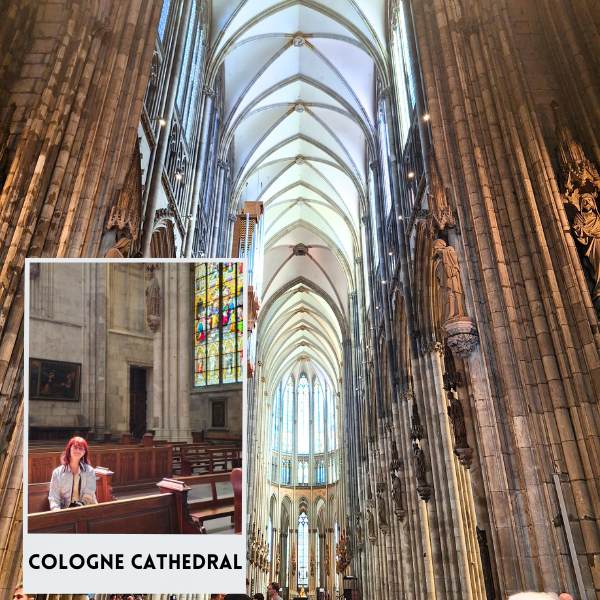
It's no wonder the Kölner Dom is one of the most famous cathedrals in the world. (And yes, it's on the UNESCO World Heritage Site list.) The interior is intricate, and the massive 20,000 square feet of stained-glass windows bring the whole appearance together. The ceiling was so tall that my camera couldn't even get the whole thing, top to bottom, in the frame. Every inch of this place is a mastery in architecture.
See the shining relic, "Shrine of the Three Kings," of solid gold near the high altar of black marble. It's both easy and hard to miss. It's hard to miss because a crowd will most likely be gazing at it, but easy to miss due to the massiveness of the Cathedral.
Regret? An Opportunity To Return.
When you visit Cologne, it is easy to find memorabilia of the Cathedral as it is Cologne's icon and mascot. I came across some incredibly detailed figurines that perfectly captured the details of the structure. It would have been an amazing keepsake, if I weren't so nervous about it breaking in the airport. I may need to go back and bring bubble wrap! Anything for an excuse to see the Cathedral again.
Regensburg Cathedral
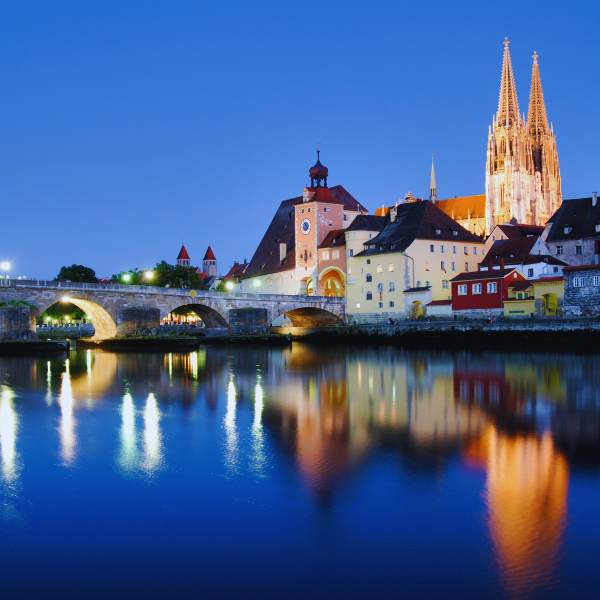
The Regensburg Cathedral is also known as St. Peter's Cathedral of Regensburg. The front view of the cathedral may seem similar to the Cologne Cathedral due to the use of similar Gothic attributes. While it may not be 500 feet high like the Cologne one, it's still just as impressive. Think of it as a baby Cologne Cathedral at 105 feet high.
It may not be as tall, but it is older by about 300 years. So, not really a baby ... more of an older, shorter relative?
Regensburg has one impressive landmark. I mean, check out that view of the gleaming cathedral spires radiating off the water with the famous 16-arch Old Stone Bridge. Now that's a beautiful sight.
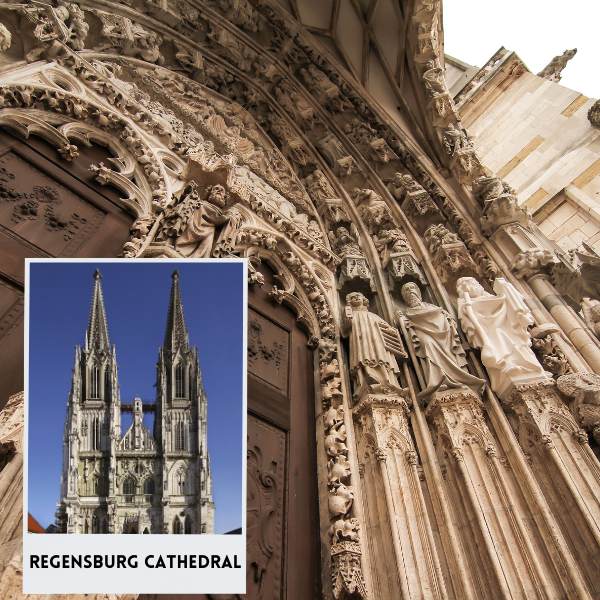
Notice that piece that looks like a bridge in between the towers? That piece was added as a way of transporting building materials during the construction of the towers. Now it is still operational, and the maintenance workers use this spot to stay 'on top' of the upkeep of those towers.
Regensburg Cathedral is known for having some of the best choirs around. If you're looking to join in and sing along, you certainly can, too. The independent choirs perform for weddings and other churches. The cathedral also has some lovely relics, along with the outstanding choirs and bells sounding daily for tourists to hear. There is one gold piece that is small but mighty beautiful and a true display of artistry: an itty bitty 2-inch golden butterfly that encapsulates the crucifix scene on its wings.
Cathedral of Our Dear Lady of Munich
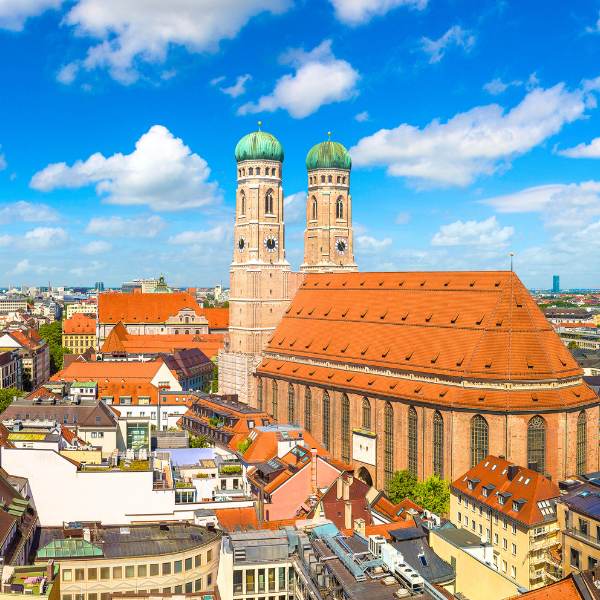
The Frauenkirche, Cathedral of our Dear Lady in Munich, is right off the Marketplatz, the market square. Snag a guided tour of this place if you can. Tours are open to the public from Monday-Saturday. The tours will be guided by the pastors, who take you through every detail of the rich history and architecture of the Cathedral.
I know what you're thinking. How can this be a Cathedral if it doesn't have the Gothic style or any other attributes of a cathedral? The easy answer is that only some states had such drastic amounts to spend on crafting structures so intricate.
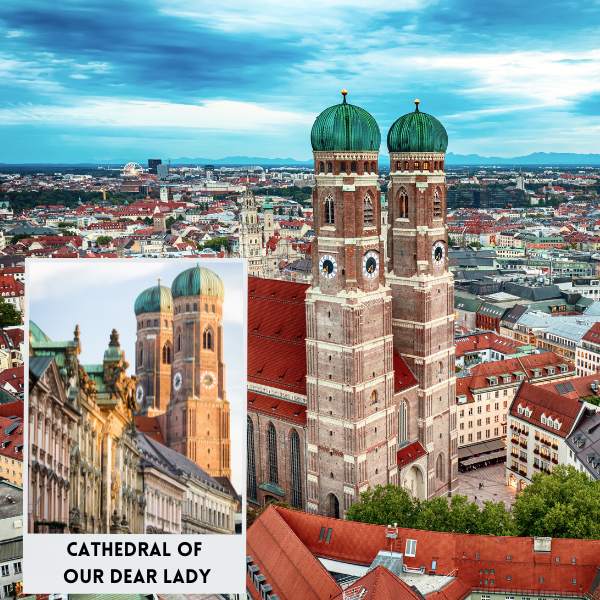
Breaking the Bank
The Frauenkirche was planned and blueprinted in 1468 to be Gothic, like the other cathedrals we've covered, but the budget just wasn't there. A simpler design was chosen to give the city its cathedral quicker and without draining everyone's pockets. Believe it or not, those majestic Baroque-style bubbles are actually fairly cheap!
The finishing touches of the towers weren't completed until 1520 and quickly became a highly respected part of town. A bill was passed that no other buildings within a certain radius could be built taller than the cathedral.
See those beautiful pointed windows near the tip-top of the towers? You can get a personal view of Munich from there. During your visit, you can climb a few dozen steps and take an elevator to a viewpoint in the South Tower. Look down below to see the ant-like size city life below. After the workout of a climb back down, relax and stroll around one of the largest cathedral halls in southern Germany.
Get out of here!
These halls hold an amazing display of Romanesque artworks that people from all over Munich come just to see. Another must-see of the Frauenkirche is the 'Devil's footprint': a large square tile near the entrance with a black footprint imprinted inside. There are a few spooky stories that come with the tour of this tile.
One being that the devil visited the church as it was being built and made a deal with the builders not to put any windows in, so he could reside there. But the builders went ahead and put in multiple windows to keep him out of the holy place. Now his footprint is trapped in that square as a "memory" of where he once stood to try to take the church. Wow! This compelling tale is almost as eerie as that of the Pied Piper!
That wraps up our tour of some of Germany's famous churches and cathedrals. Which one will you be visiting first? Or will you take a whole tour and see as many as you can?
Here's a fun activity to do with the kids along the way: Count how many windows or arches you can find in every cathedral or church you see!



























